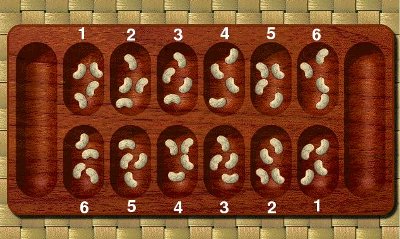
by John P. Pratt
Wed 9 Sep 2009
Basic rules for all variations.
 |
The rules and terms used for all Mancala games were given previously. Basic Mancala usually begins with four seeds in each pit, but any number from three to six can be used. The only additional rules in Basic Mancala are that:
1. When the seeds are sown, the player's capture pit is included in the sowing. In fact, that is the only way to capture seeds in this version.
It is useful to number the pits just for the purpose of describing moves. There does not seem to be a universally accepted numbering system. The one used here is shown in Figure 1. The bottom six numbers refer to the pits of the "Lower Player" (meaning playing at the bottom of the illustration), and the other six pits belong to the "Upper Player".
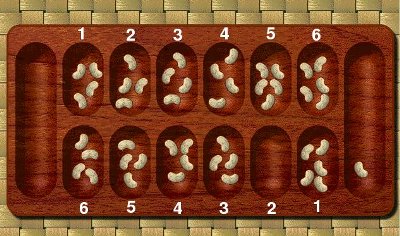 |
2. When one player cannot play because he is out of seeds, the game ends. The seeds remaining in the other player's pits are not captured.
As in all of the games described here, the winner is the one with the most stones captured.
This is a good game to introduce to children, to get the idea, but usually they are soon
ready for the three additional rules used in Egyptian Mancala. To most players, the
Egyptian version is better.
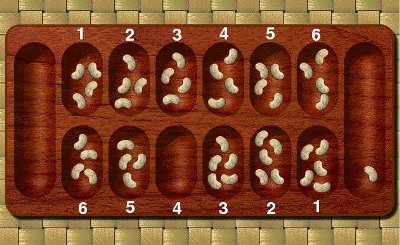 |
1. When the seeds are sown, the player's capture pit is included in the sowing. This is the same as in Basic Mancala. If there are enough seeds to go all the way around the board, then the orignal pit is skipped in the sowing. That is, after a move, the pit which was moved is always left empty.
2. If the last seed sown by a player lands in his capture pit, then he takes another turn. Figure 3 shows the board after the Lower Player moves from his Pit 4 on the first move of the game.
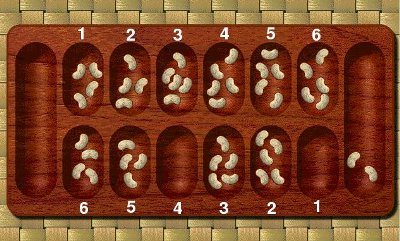 |
3. If the final seed sown lands in a seedless pit on the player's side, and the opponent's pit opposite is not empty, then all of the seeds in that pit are captured as well as the final seed sown. That ends the move. If the final seed lands in an empty pit on the opponent's side, then no seeds are captured. Continuing in the current example, look again at Figure 4. The Lower Player is threatening to capture all five seeds in the Upper Player's Pit 6 by playing Pit 5 on his next move. So the Upper Player chooses to play Pit 2 which will add a seed to the Lower Player's Pit 4, thus preventing that particular capture. Figure 5 shows the board after that move.
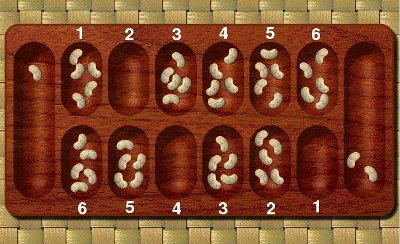 |
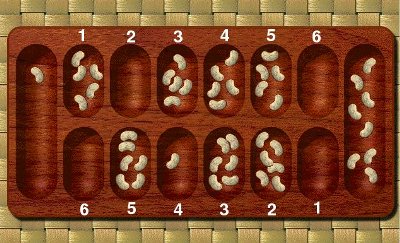 |
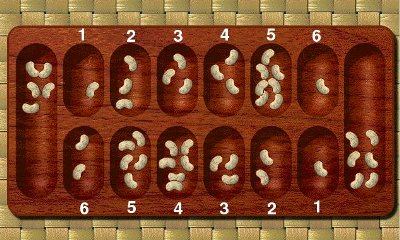 |
Because of such multiple moves, it is usually a good strategy to keep to lower numbered pits empty or with the same number of seeds in them as their pit number. Notice that in this case, Pits 1, 2, 3, and 5 have 1, 2, 3, and 5 seeds in them, respectively. The trick is to keep clearing those lower numbered pits and carefully choose the order of play.
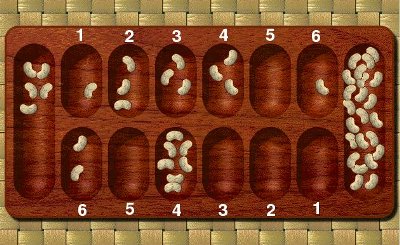 |
4. When one player cannot move when it is his turn because all of his pits are empty, the other player captures all of the seeds remaining in his pits. This means that at some point in the game, and "end game" strategy begins, where each player tries to keep all the seeds in the pits on his side by forcing the other player to run out of seeds first. This can get very interesting if either player has one pit with a large number of seeds that he is trying not to pass to his opponent.
This version adds some more complexity for those who feel they have mastered Egyptian Mancala.
1. Use all the rules for Egyptian Mancala.
2. One may move to the right (counterclockwise) or to the left (clockwise) on each turn. This really leaves one's head spinning! Of course, one's own capture pit is always included in the sowing, and seeds are never placed in the opponent's capture pit. The rule for the extra turn still holds going either way if the last seed ends in the capture pit.
3. A pit with only one seed can never be played. That makes it more difficult to capture, which could get out of control by being able to move either direction. Moreover, it means that the game will usually end before all of the pits on either side are emptied.
If that is not enough, there are other possible variations. One that occurred to me is that the number of seeds in each of the twelve pits at the beginning of the game can be chosen by one player to hold any number of seeds (from zero to as many will fit). Then the other player gets to pick which side of the board he wants to play and also who plays first. This gets rid of any memorized openings!